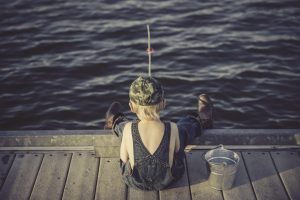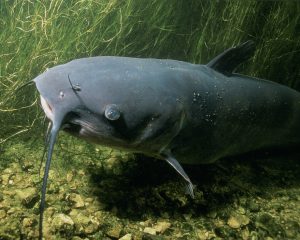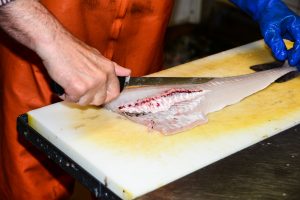 Fish consumption advisories help Virginia anglers make educated choices about eating the fish they catch. While most Virginia waters do not have dangerous levels of contaminants, some fish in certain waters are found to contain contaminants at levels of concern.
Fish consumption advisories help Virginia anglers make educated choices about eating the fish they catch. While most Virginia waters do not have dangerous levels of contaminants, some fish in certain waters are found to contain contaminants at levels of concern.
A fish consumption advisory is not a prohibition of eating fish, but a warning about the contaminants present in a fish species. Each advisory specifies the waterbody or segment of a waterbody affected, the contaminants present, and meal recommendations for eating specific fish species caught there. The meal recommendations presented in the fish advisory tables were developed to protect the general public* from adverse health effects from exposure to fish contaminants. It is recommended to follow the guidance presented on advisories to reduce your total exposure to fish contaminants.
*Women who are pregnant or may become pregnant, nursing mothers, and young children are advised not to eat any fish contaminated either with polychlorinated biphenyls (PCBs) or mercury from the respective advisory areas.

Contaminants such as mercury, polychlorinated biphenyls (PCBs), and Kepone can be found in some species of fish in Virginia waterways. These contaminants can enter waterways in a variety of ways, including illegal dumping or accidental release. Mercury can enter waterways through atmospheric deposition from sources very far away. Fish and shellfish are also known to be a dietary sources of organic arsenic. The amount of organic arsenic found in fish and shellfish is usually 90 % of the total arsenic, and is known to have low toxicity for humans. Therefore, fish consumption advisories due to arsenic in fish are very rare.
Most of the fish consumption advisories in Virginia are for mercury and PCBs. When these contaminants are present in waterbodies they are known to bioaccumulate, which means that they can accumulate in fish tissues over time. Furthermore, they can biomagnify, which means that the concentration of the chemicals found in fish tissues will increase as they move up the food chain. For this reason, older, larger and carnivorous fish tend to be the ones that have advisories. For more information about the health effects associated with these contaminants, please click on the fact sheets for Mercury or Polychlorinated Biphenyls (PCBs).
Click on a link below to view the current fish consumption advisory for a specified river basin:
- Chesapeake Bay and Small Coastal Basin (includes Great Wicomico, Piankatank, Poquoson, Lynnhaven, Pocomoke Rivers; Dragon Run Swamp; and Mobjack Bay)
- Chowan and Great Dismal Swamp Basin (includes Nottoway, Meherrin, and Blackwater Rivers; Lake Drummond)
- James River Basin (includes Maury, Jackson, Slate, Rivanna, Tye, Rockfish, Willis, Appomattox, Chickahominy, Pagan, Nansemond, and Elizabeth Rivers)
- New River Basin (includes Little and Bluestone Rivers; Walker, Peak, and Reed Creeks; Claytor Lake)
- Potomac River Basin (includes Occoquan River)
- Rappahannock River Basin (includes Hazel, Thornton, Rapidan, Robinson, and Corrotoman Rivers; and Mountain Run)
- Roanoke and Yadkin River Basin (includes Little Otter, Big Otter, Pigg, Dan, Smith, and Banister Rivers; Smith Mountain, Leesville Lakes; Lake Gaston; Kerr Reservoir; and Lovills Creek Lake)
- Shenandoah River Basin (includes South, North, South Fork Shenandoah, and North Fork Shenandoah Rivers)
- Tennessee and Big Sandy River Basin (includes Holston, Clinch, Powell, and Guest Rivers; Levisa, Russell, and Tug Forks)
- York River Basin (includes Pamunkey, Mattaponi, Lake Anna, Little, Matta, Po, and Ni Rivers)
Fish provide substantial human health benefits. They are low in saturated fat, high in protein, and a good source of omega-3 fatty acids. Fish contain vitamin D, calcium, iron, magnesium, as well as other nutrients that are beneficial for human health. Fish consumption has been linked to a decreased risk of heart attack, stroke, and high blood pressure. Fish consumption may also contribute to immune system strengthening, healthy brain functioning, and proper infant growth and development. To achieve the health benefits of eating fish, it is advised to eat a variety of fish and shellfish that are low in mercury such as salmon, tilapia, shrimp, oysters, scallops, and sardines.
You can reduce the fat and contaminants (e.g. pesticides, PCBs) in the fish you eat. To reduce the potential harmful effects from eating contaminated fish, VDH recommends the following:

- Eat smaller, younger fish. Younger fish are less likely to contain harmful levels of contaminants than older, larger fish.
- Remove the skin, the fat from the belly and top, and the internal organs before cooking the fish.
- Bake, broil, or grill on an open rack to allow fats to drain. Avoid pan frying in butter or animal fat because these methods hold fat juices.
- Discard the fat that cooks out of the fish, and avoid or reduce the amount of fish drippings that are used to flavor the meal.
- Eat less deep fried fish since frying seals contaminants into the fatty tissue.
Fish tissue and sediment samples are routinely sampled in state waters for contaminant analysis. VDH uses this fish tissue sampling data to update and create new advisories as needed when the contaminants in fish exceed levels of concerns. Advisories provide guidance to the public to make informed choices about eating locally caught fish. Virginia's fish consumption advisories are reviewed annually.
- For questions about human health risks from exposure to fish contaminants, please contact the Virginia Department of Health (VDH) at (804) 864-8182.
- For general questions about fishing regulations in Virginia, please call the Department of Wildlife Resources (DWR) at (804) 367-1000, or visit their webpage by clicking here.
- For further information regarding the fish tissue sampling and analysis process, please visit the Department of Environmental Quality (DEQ) website by clicking here, or call (804) 698-4000.
Click the links below to access fish consumption advisories in multiple languages.
Search the table below to view the current fish consumption advisories:
Hint: type in which species, locality, waterbody, or contaminant you are interested in to filter results.
| River Basin | Waterbody | Section | Locality | Contaminants | Fish Species | Advisory Description |
|---|---|---|---|---|---|---|
| Chesapeake Bay and Coastal Basin | Lake Trashmore | Entire lake | Virginia Beach City | Mercury | Largemouth Bass | ≤ 2 meals/month |
| Chesapeake Bay and Coastal Basin | Lake Trashmore | Entire lake | Virginia Beach City | PCBs | Carp | ≤ 2 meals/month |
| Chesapeake Bay and Coastal Basin | Lake Whitehurst | Entire lake, including Little Creek Reservoir | Virginia Beach City, Norfolk City | PCBs | Carp, Gizzard Shad | ≤ 2 meals/month |
| Chesapeake Bay and Coastal Basin | Lake Whitehurst | Entire lake, including Little Creek Reservoir | Virginia Beach City, Norfolk City | Mercury | Carp | ≤ 2 meals/month |
| Chesapeake Bay and Coastal Basin | Little Creek | 4 miles near US Naval Reservation Little Creek Amphibious Base | Virginia Beach City, Norfolk City | PCBs | Spot, Croaker, Gizzard Shad | ≤ 2 meals/month |
| Chesapeake Bay and Coastal Basin | Chesapeake Bay | Mainstem and its small coastal tidal tributaries | Chesapeake Bay | PCBs | Anadromous Striped Bass | ≤ 2 meals/month |
| Chesapeake Bay and Coastal Basin | Eastern Branch Lynnhaven River | 6 miles | Virginia Beach City | PCBs | Gizzard Shad | ≤ 2 meals/month |
| Chesapeake Bay and Coastal Basin | Mobjack Bay | Including tributaries | Mathews Co., Gloucester Co. | PCBs | Gizzard Shad | ≤ 2 meals/month |
| Chesapeake Bay and Coastal Basin | Tabb Creek | Entire 2 mile creek | Hampton City, Poquoson City | PCBs | Gizzard Shad | Do Not Eat |
| Chesapeake Bay and Coastal Basin | Tabb Creek | Entire 2 mile creek | Hampton City, Poquoson City | PCBs | Croaker, Striped Bass, Blue Crab, Oyster | ≤ 2 meals/month |
Specific information about Virginia's advisories can be found in the interactive map below, or by clicking here. Use the search bar to find a particular body of water, or the "my location" button ![]() to zoom to your current location. Information about individual river basins can be found below under Current Fish Consumption Advisories. If the map has trouble loading, use the "home" button
to zoom to your current location. Information about individual river basins can be found below under Current Fish Consumption Advisories. If the map has trouble loading, use the "home" button ![]() to load the map to the correct view.
to load the map to the correct view.

